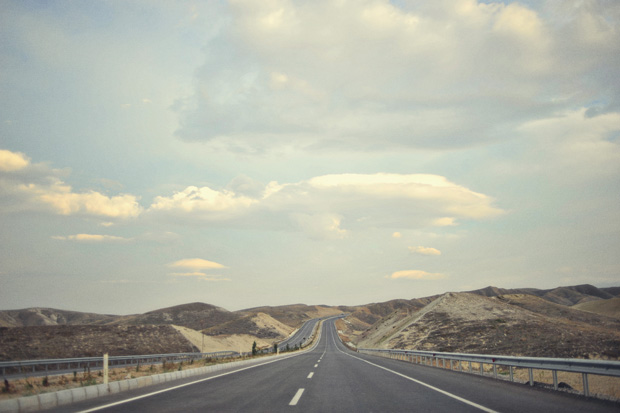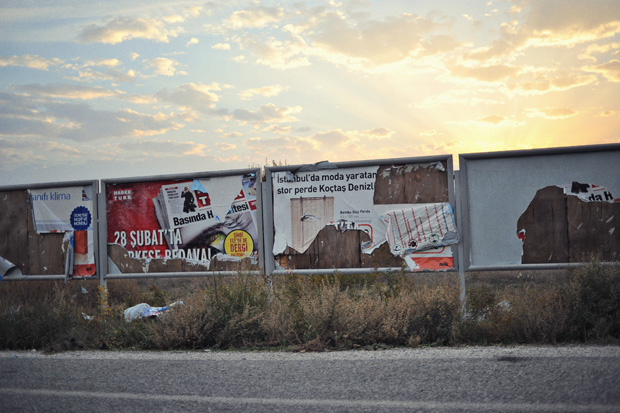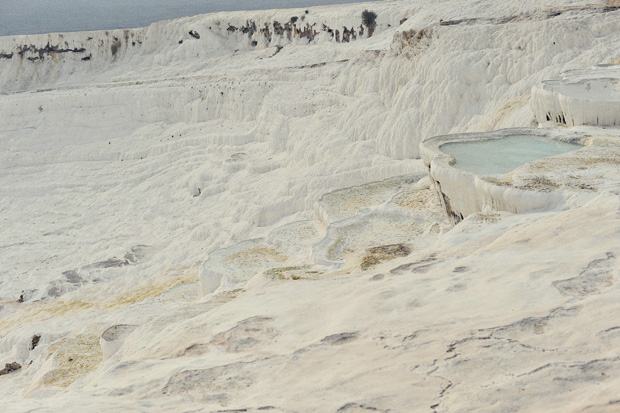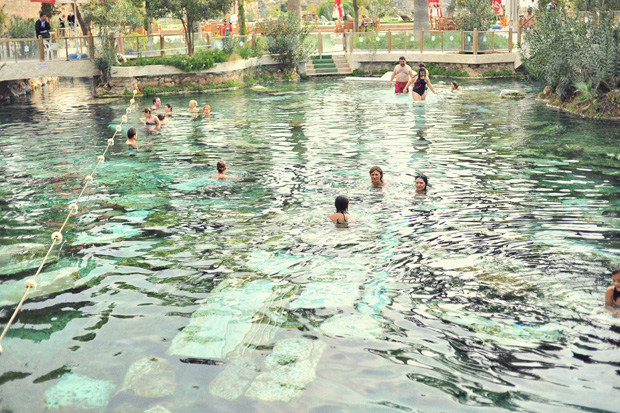After Ephesus, our little rental car took us across desert plains, fields, and sheep pastures, all the way to Pamukkale, Turkey. Along the way we saw men selling sheep near the road in preparation for the upcoming muslim holiday, Bayram. We meant for this to be a day trip, but by the time we made it to Pamukkale, the sun was setting. Short autumn days are a disadvantage for travelers. We decided to stay the night (despite the fact that we had packed nothing) so we could explore the town the next day with plenty of daylight.
In the meantime we checked in at a homey hotel and got our hotel owner, Miten, to drive us to a nearby natural hot spring which is only known by locals. He described it as a place where couples or young people hang out. A bumpy dirt road led us to a little pond in a field with steam rising out of it. Luckily we were the only ones there. Miten dropped us off and promised to return in exactly one hour. On the top of the water was a thin layer of chalky minerals which we pushed aside. The water was way too hot to even put a hand in, so we blocked the small source of running water with a rock, which channeled it to a little gutter made of dirt on the side. After waiting for about 30 minutes in the dark for it to cool down, we crept into the hot spring pool. It felt so therapeutic to soak in the wilderness under the light of the moon after a day of sitting in a car. We were out and dry at the one hour mark, but Miten wasn’t coming around. After waiting for about half an hour, we started walking down the dirt road. When we reached the main road, we waited longer, because walking along the side of the road in the dark with no sidewalk didn’t look very safe. Also, we didn’t want Miten to miss us. When we saw a police van drive by, we weren’t surprised when it turned and headed back our way. The van was full of army soldiers and after we explained our situation, they let us hop in back and gave us a drive back to town. The soldiers were all very friendly and one spoke Russian so we chatted a bit. Miten had apparently forgotten to pick us up and apologized profusely, even trying to make up for it with free beers. We thought the hour of waiting around was worth it for the laugh and the experience.
The next day we did a tour of Pumakkle and the ancient city of Hieropolis with Miten, from whom we learned a lot. Pumukkale means “cotton castle” and when you see the photographs, you will understand why. The area is covered with natural hot springs. These waters coming up from the earth have formed natural pools in the hill side and leave behind sediments of calcium. This gooey stuff eventually hardens under the sun and turns bright white and rock hard. This "white castle" is 1,970 feet wide and 525 feet tall. For centuries, people came to this place to bathe in the healing waters. In 1985, Pamukkale became a Unesco World Heritage site and hotels and roads on the "cotton castle" were destroyed and bathing banned in the pools. Now you can only walk with your bare feet through designated shallow pools which isn't nearly as cool, but the view from there is a rare beauty. A little further on you can swim in a natural hot pool which is unique since the floor of the pool is littered with pieces of columns and ancient Roman ruins. The pool (and sunken ruins) was naturally formed by an earthquake, and now those lucky Turks are making some serious money off it.
The ancient city of Hieropolis, or "Holy City", was built on the mountain above Pamukkale. It was an ancient Greek then Roman city after 2 BC, with a population of 140,000. We learned a neat little trick about calculating the population of an ancient city-- multiply the capacity of the theater by ten. Hieropolis is the mythical birthplace of Hades, the god of the underworld. There is a cave in the area that emits poisonous gas which is the supposed entrance to hell. Curiously, anyone who enters never comes back. Apostle Philip lived here and has a memorial in the city. He was killed by the Romans because Christianity was forbidden at this point. Unique things about Hieropolis: largest traditional Roman bath house, largest collection of tombs in ancient world (more than 5000), and longest ancient main street in Turkey (1100 meters). Because of the hard calcium deposits from the natural hot springs, excavating this city is a major pain. Usually archaeologists have to dig through dirt, but here they chip away at a sedimentary rock. Italians started excavating this city in the 1950s, and have a looong way to go.
- Julia




















































